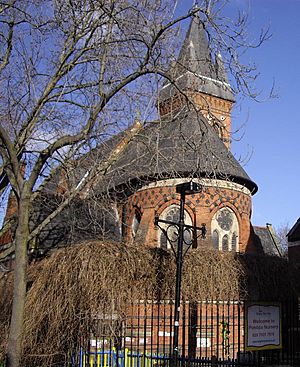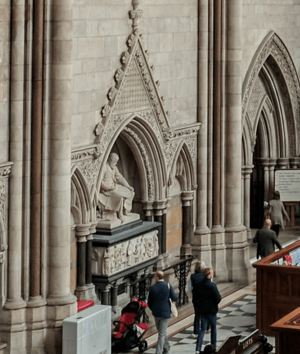George Edmund Street facts for kids
Quick facts for kids
George Edmund Street
|
|
|---|---|
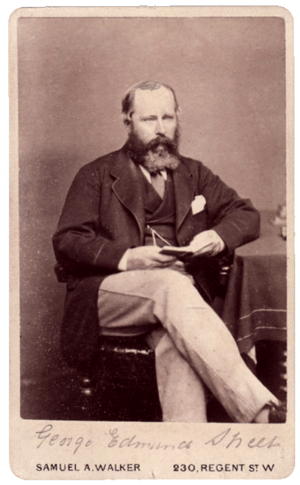 |
|
| Born | 20 June 1824 Woodford, Essex
|
| Died | 18 December 1881 (aged 57) London
|
| Occupation | Architect |
| Awards | Royal Gold Medal (1874) |
| Buildings | Royal Courts of Justice, The Strand, London |
George Edmund Street RA (born June 20, 1824 – died December 18, 1881) was a famous English architect. He was also known as G. E. Street. He was born in Woodford, Essex.
Street was a leading architect in the Victorian Gothic Revival style. This style brought back medieval Gothic designs. Even though he mostly designed churches, he is best known for designing the Royal Courts of Justice in London.
Contents
Early Life and Training
George Edmund Street was the third son of Thomas Street, a lawyer. He went to school in Mitcham and later at Camberwell Collegiate School. After school, he worked for a short time in his father's business.
When his father died, George moved to Exeter with his mother and sister. There, he became interested in architecture. In 1841, he started learning architecture with Owen Browne Carter in Winchester. After that, he worked for five years with another famous architect, George Gilbert Scott, in London.
While still working for Scott, George got his first job. He designed Biscovey Church in Cornwall. In 1849, he opened his own architecture office. Many of his first projects were in Cornwall, often restoring old churches.
A Busy Career
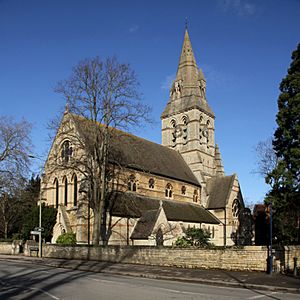
In 1850, George Street was chosen as the architect for the diocese of Oxford. He moved to Wantage, where he had already designed a vicarage (a priest's house) and some schools. In 1852, he moved to Oxford.
He designed churches like the parish church of SS Philip and James in the city. He also restored many other churches. Street built or restored 113 churches in the Oxford area! However, he did not do much work for Oxford University. His son, Arthur Edmund Street, thought this was because his father preferred older Gothic styles.
Street liked to use different colored materials in his buildings. This was called "constructional polychromy". You can see this in churches like All Saints, Boyne Hill.
At first, he believed architects should also help decorate their buildings. He even painted murals in Boyne Hill church himself. But as he got busier, he realized this was too difficult.
He moved back to London in 1855. Around this time, he entered a competition to design a new cathedral in Lille, France, and won second prize. He also came second in a competition for the Crimea Memorial Church in Constantinople, but he still got the job. He also tried to design new buildings for the Foreign Office and the National Gallery, but his Gothic designs were not chosen.
The Gothic Revival Style
George Street was a very active member of the Ecclesiological Society. This group promoted the Gothic style in church architecture. From a young age, he loved Gothic architecture. He traveled a lot in Europe to study and draw Gothic buildings. He was an amazing artist and draughtsman.
In 1855, he published a detailed book about The Brick and Marble Architecture of Northern Italy. Later, in 1865, he wrote a book about The Gothic Architecture of Spain. These books encouraged other British architects to use different colored materials in their buildings. Sometimes, people jokingly called this the "Streaky Bacon Style" because of the stripes of color.
One of his famous churches is St. James the Less in Westminster (built 1858–1861). He used red bricks with black brick patterns inside and out. The church has a tall, square tower, like those found in Genoa, Italy. A writer named Charles Locke Eastlake said in 1872 that this church showed how architects were moving away from traditional English styles. They were inspired by medieval Italian architecture and French designs.
Street especially liked to use round apses (curved ends of a church) and special louvered windows in bell towers.
In 1867, he was asked to design parts of Dunecht House in Aberdeenshire, Scotland. This included a library and a chapel.
By 1868, Street was the official architect for several important church areas (dioceses), including Ripon, York, Oxford, and later Winchester. He also became the architect for famous cathedrals like York Minster, Salisbury, and Carlisle Cathedral.
Famous Buildings
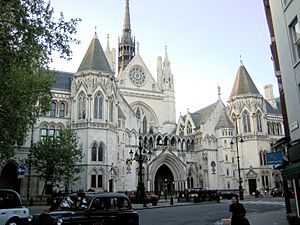
Street's most famous building is probably the Law Courts (now called the Royal Courts of Justice) in London. The competition to design this building was very long and had many different opinions. In 1868, Street was finally chosen as the main architect. Sadly, the building was not finished when he died in 1881.
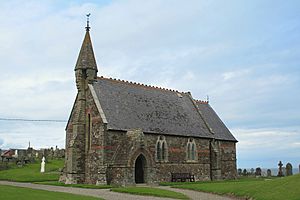
Most of Street's other work was for churches. Some of his biggest projects include the nave (main part) of Bristol Cathedral and the restoration of Christ Church Cathedral, Dublin. Other important works include St Margaret's convent in East Grinstead and the theological college at Cuddesdon.
He also designed churches for the American Episcopal Church in Rome and Paris. The one in Paris was finished after his death by his son. While he mostly worked in the Gothic Revival style, he also designed some buildings in other styles. For example, he designed a temple at West Norwood Cemetery in a Lycian-Byzantine style. He also rebuilt All Saints' at Roydon in a style that matched its old Norman doorways. Street also designed the family chapel at Gwrych Castle in Abergele.
Work in Ireland
Street designed several new buildings in Ireland. These include the small church of St. John the Evangelist at Ardamine, Co. Wexford, and Piltown Church, Co. Kilkenny.
His most important work in Ireland was the rebuilding of the historic Christ Church Cathedral, Dublin. During this project, he removed the old choir section, which he thought was not historically important. He also designed the Synod Hall next to the cathedral. He also restored St. Brigid's Cathedral in Kildare Town. It was a ruin without a roof when he started, but it reopened in 1896. He rebuilt the lost walls to match the original parts that remained.
Awards and Recognition
George Street became an associate of the Royal Academy in 1866 and a full member in 1871. At the time of his death, he was a professor of architecture at the Royal Academy. He also served as the president of the Royal Institute of British Architects.
He was also a member of the Royal Academy of Vienna. In 1878, he was given the Legion of Honour award from France for his drawings at the Paris Exhibition.
Students and Apprentices
Many future architects and designers learned from George Street. In 1856–1857, Philip Webb was his main assistant, and a young William Morris was one of his apprentices. These two later worked together on the Red House. This house became famous for showing William Morris's design ideas. Another student in the early 1870s was the Canadian architect Frank Darling.
Personal Life
George Street was married twice. His first wife was Mariquita Proctor, who died in 1874. They met when Street was restoring a church where her uncle was the rector. His second wife was Jessie Holland. They married in 1876, but she sadly died eight weeks later from a fever she caught on their honeymoon in Rome.
His son, Arthur Edmund Street, was born in Oxford in 1855. Arthur joined his father's office in 1878. After his father's death, Arthur finished the buildings that were still being built. He later wrote a book about his father's life in 1888.
George Street died on December 18, 1881, at the age of 57. He worked very hard, and the stress of building the Law Courts likely made him sick. He was buried in Westminster Abbey, near the tombs of other famous architects. A monument to Street, paid for by the Prince of Wales, was placed in the main hall of the Royal Courts of Justice. It was unveiled in 1886.
Street was a strong supporter of the high church tradition in the Church of England. For many years, he was a churchwarden (a church official) at All Saints, Margaret Street in London. He strongly believed that all seats in churches should be free, not rented out.
See also
 In Spanish: George Edmund Street para niños
In Spanish: George Edmund Street para niños
- List of new churches by G. E. Street
- List of church restorations and alterations by G. E. Street
- List of domestic buildings by G. E. Street
- List of miscellaneous works by G. E. Street


